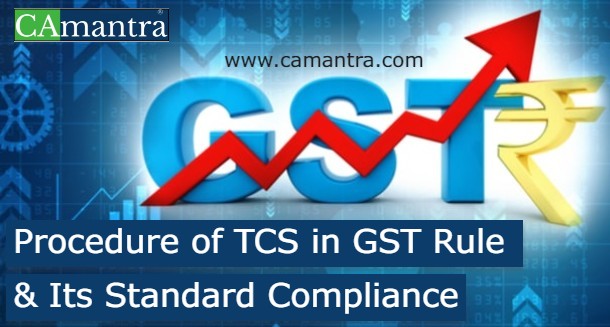The Union Budget 2021 has given an easy route to comply the TCS under GST Rule. TCS also known as Tax Collection at Source has similarities with TDS and also have distinctive features. TDS refers to tax deducted when recipient of goods/services makes some payments under a contract etc. TCS refers to tax which is collected by the e-commerce operator when a supplier supplies some goods or services through their portal & the payment for that supply is collected by the electronic commerce operator.
We can understand the exact nature of TCS with an example. There are many electronic Commerce operators such as Amazon, Flipkart etc. operating in India. These operators display their products as well as services which are actually supplied by some other person to the consumer. The goods or services belongs to other suppliers are displayed on the portals of the operators & consumers buy these kind of goods/services by these portals. On placing the order for a particular product or services the actual supplier supplies the selected product or services to the consumer. The cost for the product or services is collected by the Operator from the consumer & passed on to the actual supplier after deducting his commission by the Operator. The Government has given the responsibility on the Operator to collect the ‘tax’ @ 1% from the supplier. This will be done by the Operator by paying the supplier the cost of the product /services, less the tax, calculated @ 1%. The said amount will be calculated on the good’s/service’s net value which are supplied through the portal of the operator.
Let’s assume that a certain product is sold at INR 1000/- through an Operator by a seller. The Operator would deduct tax at the rate of 1% of the net value of INR 1000 which is INR 100.
Let us have a look at the statutory provisions related with TCS:-
Registration: The e-commerce operator as well as the supplier supplying goods or services through an operator need to register essentially under GST. The threshold limit of INR 20 lacs (INR 10 lacs for special category states) is not applicable to them. CGST Act, 2017 – Section 24(x) makes it mandatory for every e-Commerce Operator to get registered under GST. Similarly, section 24(ix) of the CGST Act, 2017 makes it essential for every person who supplies goods or services through an Operator to get registered under GST.
Power to Collect Tax: The CGST Act, 2017- Section 52 provides for Tax Collection at source, by e-Commerce operator in respect of the taxable supplies made through it by other suppliers, where the consideration in respect of such supplies is collected by him/her.
When the below-mentioned goods are utilized for manufacturing purpose, processing purpose, or producing things purpose, the taxes are not payable. If the same goods are utilized for the purpose of trading then tax is payable. The payable tax is collected by the seller at the point of sale.
Rate of TCS: The dealers or traders supplying goods and/or services through e-commerce operators will receive payment after deduction of TCS at the rate of 1%. The rate is notified by the CBIC in Notification number 52/2018 under CGST Act & 02/2018 under IGST Act. This means for an intra-state supply Tax Collection at Source @ 1% will be collected, which is 0.5 % under CGST and 0.5% under SGST. Similarly, for a transaction between the states, the TCS rate will be 1%, which is under the IGST Act.
Tax Collection at Source Statement: The tax amount so collected by the operator is needed to be deposited by the 10th of the following month, during which such collection is made. The operator is also required to make a monthly statement in Form GSTR-8 by the 10th of the following month. The Operator is also needed to file an Annual statement in prescribed form by the 31st of December following the end of every FY. The Operator can purge errors in statements filed, if any, latest by the return to be filed for the month of September, following the end of every financial year.
The details made by the operator in GSTR-8 will be made available electronically to each of the suppliers in FORM GSTR-2A- Part C on the Common Portal after the due date of filing of FORM GSTR-8.
Credit of Tax Collected: The tax collected by the operator shall be credited to the cash ledger of the supplier through the Operator. The supplier can claim tax credit collected and reflected in the tax return by the Operator in supplier’s electronic cash ledger.
Matching of supplies Detail: The details of the supplies, value of supplies, submitted by every operator in the statements will be matched with the details of supplies submitted by all such suppliers in their returns. If there is any differences in the value of supplies, the same would be communicated to both of them. If such differences in value is not rectified within the given time, then such amount would be added to the output tax liability of such suppler. The supplier will have to pay the difference amount of output tax along with interest.
Notice to the Operator: An officer not below the rank of Deputy Commissioner can issue notice to an Operator asking him/her to furnish details relating to volume of goods/ services supplied, stock of goods lying in warehouses or godowns etc. The Operator is required to give such details within 15 working days. In case an Operator fails to furnish the information, besides being liable for penal action under section 122 shall also be liable for penalty up to INR 25,000.

